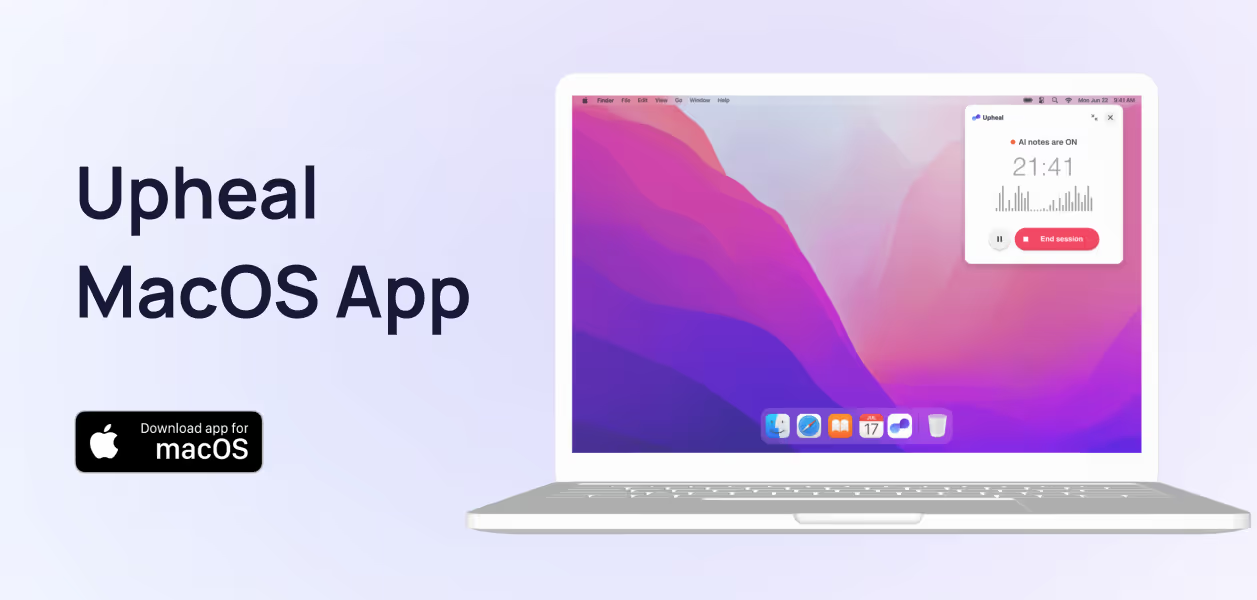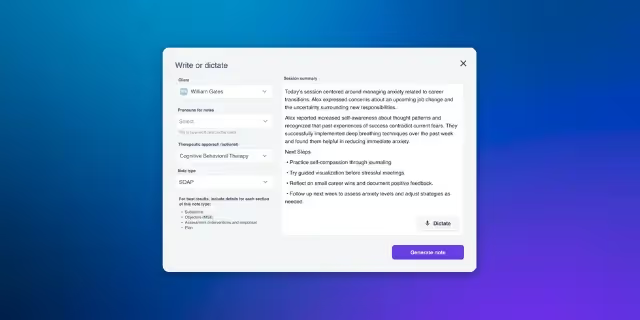Tips for therapists with ADHD: how to look after your clients and yourself

ADHD — attention-deficit/hyperactivity disorder — affects everything from your executive functioning to your emotional regulation. This can cause problems in any profession, but therapists with ADHD face a few unique challenges.
It’s unclear how many therapists have ADHD, but we do know that about 15.5 million adults in the U.S. have the disorder (that they know of). So, we’re willing to bet there are quite a few therapists in there.
If you’re one of them, know that ADHD doesn’t mean you can’t work as a mental health professional. In fact, despite the challenges, you may find ADHD is your superpower, helping you provide compassionate care and valuable perspectives.
Below, we’ll dive into the hurdles therapists with ADHD might face and tips to overcome them to help you take better care of yourself and your clients.
Challenges therapists with ADHD may face
Therapists with ADHD experience the same symptoms as other adults with the disorder.
Those include:
- Having trouble focusing
- Getting easily sidetracked during tasks
- Having trouble with time management or prioritization
- Being forgetful
- Feeling restless
- Talking excessively
You might find that ADHD doesn’t affect you that much during calm periods of life. But when things get busy or stressful — perhaps your caseload increases or you feel burned out — ADHD symptoms may become more disruptive to your work and personal life.
In a therapist setting, ADHD may manifest as:
- Difficulty with attention: You might struggle to stay on track during sessions or follow what your clients are saying, especially if you’re trying to take notes while listening at the same time.
- Impulsivity: You might find yourself speaking too much or too fast during sessions, or feeling the urge to interrupt or redirect a client.
- Restlessness: You might fidget during sessions, which can be off-putting for a client, or you may feel distracted by restlessness during sessions.
- Disorganization and uncompleted tasks: You may have trouble keeping track of appointments, paperwork, and all the logistics of working with multiple clients, or completing admin tasks and necessary documentation.
- Overcommitment: You may take on an overwhelming caseload or too many additional responsibilities inside or outside of work.
- Emotional dysregulation: You may have difficulty managing emotions, which can lead to compassion fatigue, vicarious trauma, and burnout. With clients, you may struggle to stay neutral and calm, or you might find yourself people-pleasing. ADHD is also linked to rejection sensitive dysphoria (RSD), which can cause extreme reactions to rejection — like when a client disagrees with you or discontinues therapy.
As a therapist, you may be better informed about how to manage ADHD compared to people who don’t work in the mental health field. But you might also experience more shame and stigma.
You work with people on their mental health, after all, so you don’t want your own mental health to impact your clients’. This can make it hard to admit to colleagues, clients, and even yourself that you have ADHD or you’re struggling to manage it.
But it’s not all bad news.
ADHD is, firstly, nothing to be ashamed of. We’re all human — even therapists — and your brain simply works in a slightly different way.
But most importantly, ADHD doesn’t have to be a disadvantage, in therapy or any other profession.
Therapists with ADHD bring unique gifts to their work — like out-of-the-box thinking and extreme empathy — which can make them great mental health professionals. Plus, you’re primed to help neurodivergent clients as you can connect with their struggles on a more personal level.
How therapists with ADHD can look after their clients and themselves
ADHD doesn’t have to hold you, or your clients, back. The trick is learning how to manage your ADHD symptoms to take the best care of yourself and provide your clients with the support they need.
Here’s what you can try.
1. Practice mindfulness
As a therapist, you might have coached your clients on mindfulness techniques or even tried them yourself before.
When you’re busy, something like mindfulness exercises are often the first thing to go. But it’s worth investing your time in.
Studies show that mindfulness-based interventions can significantly improve attention in people with ADHD. You might find they also help with emotional regulation and impulsivity.
Mindfulness exercises include:
- Doing a body scan
- Checking in with your senses
- Doing the 4-7-8 breathing technique
Try adding mindfulness exercises to your morning routine or lunch break.
Mindfulness-based intervention has shown benefits in general, helping adults who suffer from stress, depression, pain, and illness (Hofmann, Sawyer, Witt, & Oh, 2010).
You can also use mindfulness techniques before each session or even during sessions. This could include taking five deep breaths to clear your racing mind before meeting with a client, or grounding yourself mid-session, for example, by using an anchor, to calm impulsive urges or overly emotional reactions.
2. Minimize distractions
Distractions are everywhere in life, but therapists are often juggling a lot at any one time. And that’s not always ideal if you have ADHD.
To help, minimize distractions where possible.
That could mean taking a few minutes before each session to clear clutter and organize your space, or working with noise-canceling headphones when writing up progress notes and treatment plans. Some neurodivergent folks find instrumental soft jazz or binaural beats help them focus.
For instance, our Head of Clinical Operations, Ted Faneuff, loves instrumental soft jazz or binaural beats for beta wave focus when doing deep thinking work.
Using soft jazz or binaural beats helps me to focus considerably. I also use time blocking on my calendar to prioritize tasks and create structure around my time so that I have reminders of what I need to work on next.
You can also harness AI to cut down on distractions.
For example, Upheal creates AI progress notes by temporarily capturing the audio recordings of your sessions. You won’t be distracted trying to jot down notes mid-session to jog your memory later. Instead, you can give your client 100% of your attention, knowing the important details won’t get missed.
3. Take movement breaks
It’s a basic pillar of self-care, but one that’s easy to neglect, especially if you have a large caseload or a mountain of documentation to do. But to take the best care of yourself and your clients, make movement a non-negotiable for you.
Research shows that exercise can improve cognitive performance in kids and teens with ADHD by more than 30%. And even just 30 minutes of aerobic exercise can improve cognition and inhibitory control in ADHD adults. Not bad, right?
As well as structured exercise, try squeezing in movement breaks throughout the day — like a walk around the block or some simple stretches in between sessions.
If you run a private practice or have control over your session times, consider making sessions a little shorter (or create enough of a buffer) to give yourself transition time in between clients to move and refocus. Who knows, the shorter sessions might suit your busy clients better, too.
4. Use the spoon theory
Ever used the spoon theory with clients with chronic illnesses? It can be used for your own ADHD management, too.
If you’ve never heard of it, the spoon theory uses imaginary spoons as units of energy. Stay with us, it gets better.
You only have so many “spoons” each day and everything you do — from conducting therapy sessions to reviewing client notes — takes a set number of spoons. Some tasks take more spoons than others and once you’ve used up all your spoons, you should rest until you build up more.
It sounds simple, but it can be an effective way to manage your energy, prioritize tasks, and avoid overcommitment issues.
With your spoons in mind, you can set boundaries on how many clients you take on (if that’s within your control) or reduce mentally draining tasks, so you have more spoons — aka time, focus, and energy — to spend on client-facing work or self-care.
Upheal’s AI progress notes take this spoon-draining task off your hands. But the tool can also analyze your sessions and give you insights such as:
- Client sentiment on various topics
- How long a client spends talking about the past vs. the future
- Moments of silence and on which topics or questions
With that analytical work done, you can focus your energy on what you do best — helping your clients.
5. Overcome additional ADHD barriers with new technology
Everyone experiences ADHD differently. Having a tool like Upheal can greatly support you as a therapist in several ways.
Perhaps predictably, it can help you with your notes. Whether it’s struggling with focus on note-taking or just getting your thoughts onto the page, Upheal can create the first draft of your progress notes. This speeds up tasks — like intake or discharge notes — and reduces note-taking distractions and cognitive strain during your sessions.
You don’t need to worry about forgetting anything or missing key details, freeing up time and mental energy.
But there are other benefits too, that don’t have anything to do with progress notes.
Upheal’s scheduling features help with session bookings and organization while additional session analytics help you see how much time you spend talking vs. your client, so you can adjust your rate of speech if needed.
And finally, Upheal can help you take care of your body and your physical needs, if you experience limited interoception. Since ADHD can cause you to be more externally oriented, this can lead to being disconnected from a range of important internal cues that are essential to healthy functioning.
It may sound silly, but it’s things like taking a pee break, a proper lunch time, or stopping when tired; by creating more space for yourself with Upheal you can consciously create the space to read your body and notice these signals you might otherwise override for too long.
Make being a therapist with ADHD easier
It’s very possible to manage ADHD to protect yourself from burnout and be the best therapist you can be for your clients.
Getting familiar with your own particular brand of ADHD is key, as well as creating extra support systems that reduce your cognitive load.
Using a tool like Upheal can help reduce distractions and mentally draining tasks by supporting your progress notes, helping with scheduling, and providing additional session analytics.
Try Upheal for free to see how it could help in your therapy work and dedicate your attention where it matters most – yourself and your clients.












